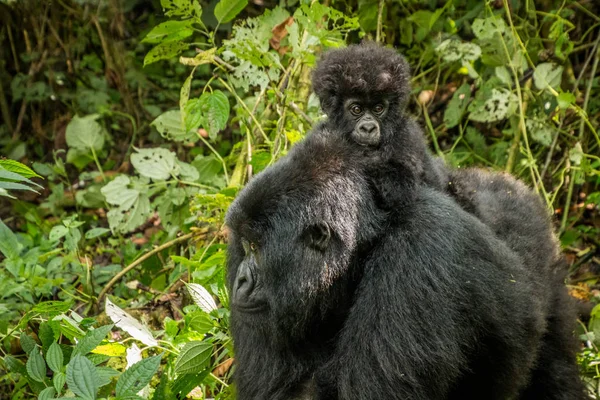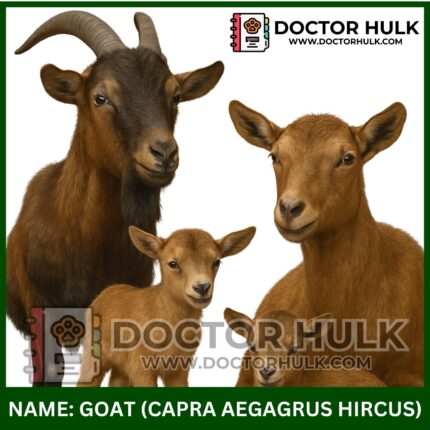Gorillas are the largest living primates on Earth. Even though they look strong and scary, they are actually calm, intelligent, and family-loving animals. They mostly live in groups and spend their time eating, resting, and playing in the forest.
Scientific Classification
-
Kingdom: Animalia
-
Phylum: Chordata
-
Class: Mammalia
-
Order: Primates
-
Family: Hominidae
-
Genus: Gorilla
There are two main species of gorillas, each with their own subspecies.
Common Names
-
Gorilla
-
Great Ape
-
“Forest King” (nickname in some cultures)
In some African communities, they are seen as wise forest spirits or family protectors.
Geographic Distribution
Gorillas live in the tropical rainforests of Central and West Africa, including:
-
Democratic Republic of Congo
-
Rwanda
-
Uganda
-
Cameroon
-
Gabon
They prefer dense forests, bamboo areas, and mountain regions depending on the type.

image showing a silverback gorilla resting in thick jungle leaves (Source: The Urge To Wander)
Physical Characteristics
-
Weight: 100–270 kg (220–600 lbs)
-
Height: Up to 1.8 meters (when standing upright)
-
Coat: Thick black or dark brown fur
-
Males: Often have silver hair on their back (“silverbacks”)
-
Face: Flat with large nostrils and expressive eyes
Their strong arms and chest help them move and protect their group.
Types of Gorillas
1. Western Gorilla (Gorilla gorilla)
 Image showing Western lowland gorilla (Source: Bwindi Impenetrable National Park)
Image showing Western lowland gorilla (Source: Bwindi Impenetrable National Park)
Key Facts:
-
Found in West and Central Africa
-
Smaller and lighter in color
-
Most commonly seen in zoos
2. Eastern Gorilla (Gorilla beringei)
 Image showing mountain gorilla with baby in foggy forest (Source: Depositphotos)
Image showing mountain gorilla with baby in foggy forest (Source: Depositphotos)
Key Facts:
-
Found in DRC, Rwanda, and Uganda
-
Includes Mountain Gorilla and Grauer’s Gorilla
-
Heavier and darker in color
What do Gorillas eat?
Gorillas are mostly herbivores, meaning they eat plants. Their diet includes:
-
Leaves and stems
-
Fruits and roots
-
Bark and bamboo
-
Occasionally ants or termites
They eat for many hours a day, using their strong jaws to chew tough plants.
Fun facts
-
Gorillas share 98% of their DNA with humans.
-
A silverback leads the group like a father and bodyguard.
-
They use tools like sticks to test water or reach food.
-
Gorillas laugh, cry, and mourn the dead just like humans.
-
A baby gorilla can cling to its mother for months.
Importance to Humans
Positives:
-
Attract tourists and support eco-tourism and conservation
-
Help spread plant seeds in forests
-
Teach us more about evolution and behavior
-
Symbol of peace, strength, and family values
Negatives:
-
May damage crops near villages
-
Can be dangerous if threatened or provoked
-
Victims of illegal hunting for bushmeat and body parts
Health & common issues
Like humans, gorillas can suffer from many of the same diseases:
Common Issues:
-
Respiratory infections (cold, flu)
-
Wounds from fights or accidents
-
Stomach upsets from bad plants
-
Skin conditions
-
Emotional stress in captivity
Veterinary Care Needs:
-
Clean environment in zoos or sanctuaries
-
Medical checks, especially for rescued or orphaned gorillas
-
Nutrition management and mental stimulation
Conservation status
-
Mountain Gorilla: Endangered
-
Western Lowland Gorilla: Critically Endangered
-
Threats: Poaching, habitat loss, diseases, war
Conservation Efforts:
-
Wildlife reserves (e.g. Virunga National Park)
-
Anti-poaching patrols
-
Education programs for locals
-
Gorilla trekking tourism for funding
Gorilla vs Chimpanzee
| Feature | Gorilla | Chimpanzee |
|---|---|---|
| Size | Much larger | Smaller and more agile |
| Strength | Stronger | More flexible |
| Temperament | Calm and peaceful | Playful and loud |
| Leadership | Silverback-led family groups | Alpha male with shifting rank |
 showing a Silverback gorilla watching over his group in the forest (Source: Uganda Safaris)
showing a Silverback gorilla watching over his group in the forest (Source: Uganda Safaris)
Just incase you want to learn more about great apes or wildlife care, you can visit Doctor Hulk Veterinary Hospital or call 08143397614.


















Reviews
There are no reviews yet.